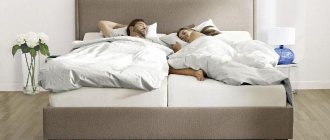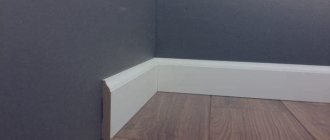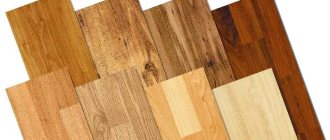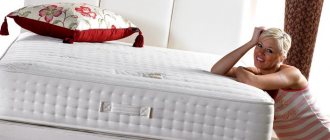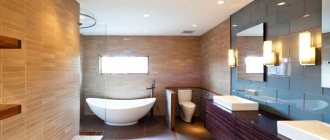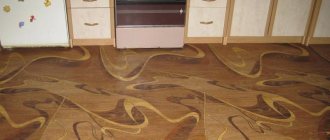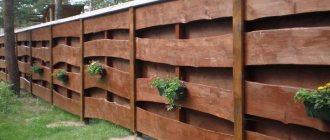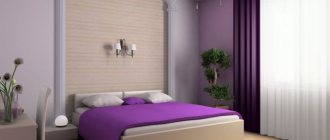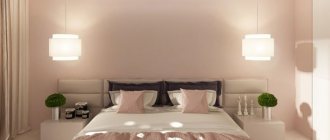Today, a very large number of consumers are supporters of covering the floor with carpet, which is a combination of carpet and linoleum, as if two in one. As a result, the resulting soft covering can be used to cover the entire floor in a house or apartment, as evidenced by numerous photos of carpet on the floor.
Ordinary people call it roll carpets because it is often sold in rolls, but it can also be purchased ready-made in certain sizes.
The composition of the carpet includes pile and base, consisting of one or two layers. To produce a single-layer base, a dense fabric made of synthetic fibers is used, into which pile bristles are embedded. A two-layer base consists of a pile and two bases, between which a fixative is placed.
Advantages and disadvantages
Before we look at all the advantages and disadvantages, we should define the concept itself.
Carpet is a rolled floor covering with pile of various lengths. The main differences from the carpet: it has an unlimited length, is laid along the entire length and width of the room, the pattern is most often small, repeating (pattern). Pros of carpet:
- Universal. There are a large number of models on sale, differing in color, pattern, and pile length: you can find one that suits any style.
- Soft to the touch. When there are small children in the house, you don’t have to worry about them playing on the floor. And adults will also enjoy walking on such a surface.
- Long lasting. Carpeting in apartments began to be laid later; initially the material was intended for decorating lobbies, corridors and foyers in hotels and public institutions.
- Eco-friendly. Suitable for use in children's and adult bedrooms.
- Insulating. The carpet not only absorbs extraneous noise, but is also an excellent heat insulator: walking on a heated floor is pleasant even barefoot.
- Easy to install. To lay it in your apartment, you don’t have to call a specialist: having certain knowledge, you can do it yourself.
- Inexpensive. The minimum price per square meter is about 260 rubles, which is 2 times cheaper than the cost of laminate.
The photo shows a light carpet in the attic interior
Disadvantages of carpeting:
- Difficult to care for. Compared to linoleum or laminate, cleaning requires more effort and time: the main debris is removed with a vacuum cleaner, and dirt will have to be additionally cleaned with a brush.
- Permeable to moisture. The carpet itself is not destroyed by water, but dampness passes through it to the base, which can lead to the appearance of fungus.
- Easily soiled. Staining, especially on light-colored flooring, is easier than you think. Be prepared to stock up on an arsenal of special tools and use them constantly.
- Dust-retaining. Any carpet is a dust collector - so if there are allergy sufferers in the family, it is better to avoid fleecy surfaces.
The photo shows the carpet in the children's room
Green carpet
We all know how strongly color design can influence our mood and perception of the interior. The color of the floor plays a big role in the overall picture. Unobtrusive green carpet goes well with many other shades. The main rule that you need to follow when choosing a floor covering is that the brighter and more saturated the color of the floor, the more neutral the other surfaces should be and vice versa. For example, light green carpet allows for brighter walls. But if the floor is bright green, then the walls should be muted gray or beige.
Designers recommend choosing shades of green for different rooms as follows:
- bedroom, living room, hallway - dark and rich colors, close to the autumn palette (mustard, olive, dark green, marsh, khaki);
- kitchen, bathroom - a summer palette of shades is more suitable here, more juicy and bright (the color of young grass, green apple, pistachio);
- other rooms - universal shades of green are the range of the winter palette (deep green, emerald, turquoise, lime, avocado, kiwi).
The right combination of green with other colors is also important. There are ready-made options for this, recommended by experts:
- Green and blue. The pleasant natural combination of sky and grass always looks natural and beautiful.
- Green and blue. This combination is already more contrasting, so it can be used in bright and bold designs.
- Green and brown. It evokes an association with a tree, so the combination is successful. It is better to use light shades of brown so as not to visually weigh down the green.
- Green and black. In this case there should be very little black. Rather, these should be small accents.
- Green and white. A very fresh combination that makes the room elegant and even, to some extent, solemn.
- Green and red. Despite the skepticism of many towards this combination, red in measured quantities looks very acceptable. In this case, you can make an association with grass and flowers.
Green long pile carpet
Long-pile carpets look chic and rich, which is why they are often chosen for the living room or bedroom. It is very pleasant to walk on them barefoot. Visually they create a very cozy and homely atmosphere. A green carpet with a long pile can be artificial or natural - both of them, provided they are of good quality, will last you a very long time. When purchasing, pay attention to the elasticity and density of the pile - the higher these indicators, the longer the product will retain its original appearance.
Green carpet "grass"
Carpet that looks like artificial green grass appeared relatively recently, but immediately gained popularity. It amazingly accurately imitates a natural lawn, so it does an excellent job of creating an atmosphere of naturalness, harmony and unity with nature. It is mainly used to decorate areas around the pool, children's play area and terraces. Artificial origin guarantees its good stability and preservation of all properties even when exposed to various atmospheric phenomena.
Indoors, soft and fluffy green carpet is also used very often. In the interior of a children's room, living room, loggia and any other room, this coating looks stunningly realistic and attractive. In addition, it simultaneously solves the issue of thermal insulation of the floor, being a soft and cozy coating. Artificial decorative grass indoors is great for many styles, pairing well with other natural textures.
Green terry carpet
Green terry carpets for the floor can differ in several parameters - the length of the terry, the degree of its softness/hardness, the material of the carpet. The choice must be made based on your own preferences and taking into account the characteristics of a particular option. So, long terry requires more thorough cleaning. Soft pile is more pleasant for walking barefoot, but not practical for the hallway. As for the material of manufacture, if there are animals in the house, then for frequent wet cleaning with a washing vacuum cleaner it is better to choose artificial carpets.
Types and characteristics
According to the method of production, carpets are distinguished:
- Tufted. It is made by punching needles with wool into the warp and forming loops from them. The technology makes the carpet rigid, but allows you to create multi-level patterns and achieve different effects by varying the depth of the pile, cutting it or leaving it whole.
- Woven. The weft and warp threads are intertwined, which makes it possible to obtain a durable, wear-resistant material.
- Needle-punched. The process is reminiscent of felting - barbed needles pull the wool back and forth, forming a dense surface. It is inferior to the first two types in beauty, but is distinguished by increased wear resistance and noise insulation characteristics.
The pile happens:
- Natural. Made from wool, cotton, linen, sisal. Almost no chemicals are used in production, so the cost is higher than synthetics. The solution is suitable for living rooms not only because of its environmental friendliness, but also due to its ability to maintain a microclimate: the fibers absorb excess moisture, and when the air becomes dry, they begin to release it.
- Synthetic. The flooring is made from polyacrylic, polyamide, and polyester threads. Their price is justifiably lower, but their resistance to stains is better: the surface can be washed and most stains can be easily removed from it.
Based on the base material, they are distinguished:
- Felt. Does not rot, suitable for wet cleaning.
- Textile. Withstands dry cleaning only.
- Rubber. Not afraid of water, but takes a very long time to dry.
- Latex. It takes a long time to dry like rubber. After 5-7 years of use it may begin to crumble.
The last difference between carpet is the scope of application:
- Domestic. Soft pile at the same time allows you to walk in socks or barefoot and complicates the maintenance process.
- Commercial. Coarser pile (designed for walking in shoes), restrained range of shades. Easier to care for. The cost is higher than household.
Selection rules
What kind of carpet to lay depends on the functional purpose of the interior.
Living room
Tufted or woven carpets with high pile will create home comfort. Feel free to use design techniques like bright colors or printed patterns.
The photo shows carpet laying in a single contour
Bedroom
Eco-friendly natural material will fit into rest rooms, but for allergy sufferers it is better to choose short-haired artificial materials.
Children's
The recommendations are the same as for the bedroom: the floor in a small child’s room should not cause allergies, but remain pleasant to the touch and suitable for playing.
Hallway
The corridors are highly trafficked and dirty. In the area of the front door it is better to abandon it in favor of practical tiles. In the rest of the room, lay a commercial or durable household option.
What to look for when choosing
Designers recommend that you carefully consider the choice of material. Choose impact-resistant materials that do not wear out or fade when exposed to sunlight. For a small living room, light material in soothing colors is suitable, which will visually expand the space and make the room brighter.
Important! If the living room is combined with a dining area, then select a material from which stubborn dirt can be easily removed.
The less natural light there is, the lighter the finish will be to compensate. The tone should be in harmony with the wallpaper and wall covering. You should not give preference to white flowers, as dirt is more visible on them. If the furniture in the room is regularly moved, then it is better to choose carpet that will not leave dents from the legs.
A dark floor looks advantageous; dirt and dust are less visible on it. But in a small room, such a carpet will visually reduce the space. You will need to use additional tricks to add space.
Design options and colors
In the design of residential premises, carpet in light basic shades is mainly used - gray, beige. But the shade options are almost endless (especially for synthetic pile carpet).
Achromatic black, white or bright peach, lemon, green, blue, red - everyone will find a suitable option for themselves.
Carpet for children's rooms is often produced with a pattern: geometric, animalistic, floral. There are also images of entire cities with houses and roads.
Important! When choosing models with a pattern, remember: carpet in the interior will last at least 10 years. Are you ready to see just such a floor every day during this time?
Color palette
The right choice of color will create an atmosphere and support the style and features of the interior. It is important to maintain harmony and compatibility with decorative items. Designer recommendations:
- warm shades will add coziness;
- cool tones will set you up for concentration;
- blue and turquoise tones will add energy and strength;
- burgundy will emphasize the abundance of items made from natural materials;
- white and gray tones look neutral.
It is worth considering that too bright colors negatively affect a person’s mood. Therefore, preference is given to muted options. Pay attention to the drawing. Thin stripes visually increase the space, large rounded shapes will emphasize oval furniture. Below is a photo of an unusual carpet in a classic living room.
Care instructions
A cozy floor covering needs 2 types of cleaning: regular and deep.
- Clean the floor at least once a week with a vacuum cleaner (it is better to use a special turbo nozzle with a rotating brush). It removes dust and refreshes the appearance.
- Once every 1-3 months (depending on the condition of the surface), deep dry cleaning is carried out. To do this, you should purchase a special carpet powder. It is distributed over the carpet, wait the time indicated on the package, and collect it with a vacuum cleaner.
Special attention is paid to the stains that have formed: they need to be removed from the carpet as quickly as possible so that the dirt does not have time to dry. The problem of fresh dirt will be solved by the same deep cleaning powder or a special stain remover.
How does it look in the interior?
Designers and home owners still do not have a common opinion about carpet: some consider it outdated and impractical, others consider it stylish and cozy. But the fact remains: the scope of application of rolled carpets is wide, and the service life depends more on the quality of the surface itself than on its care.
The photo shows high-pile carpet
If you look at photographs of foreign interiors, you will notice that in most rooms there is carpet.
The photo shows a variant of a neutral pattern for a nursery
In Russia it is used less often, but if you have helpers around the house (for example, a robot vacuum cleaner), you definitely shouldn’t be afraid: with proper care, it will retain its original appearance for many years.
Before purchasing, evaluate all the pros and cons of the carpet, carefully study the composition - only then make a decision about payment.
Carpet painting
Carpet painting is of interest to many home craftsmen, but there is practically no information on this topic on the Internet.
The desire to change the color of the carpet may arise for two reasons:
- When stains occur that cannot be washed off. Often stains, in particular coffee stains, cannot be washed off even with a vacuum cleaner. In this case, the most you can count on is to somewhat mute their color, but even in this case they clearly appear on the surface.
Removing stains from carpet may not always have the desired success.
If the covering is quite new, then you don’t want to throw it away, especially since the price of a new carpet is quite high. Therefore, the only way out of the situation is repainting. This way you can get brown carpet from beige, orange from yellow, etc.
Naturally, lighter and more delicate colors should be repainted into brighter and darker ones. In this case, the stains will be reliably masked, and you will get a completely new coating.
- The second case is that you are simply bored with the color of the coating or you have decided to make drastic changes in the interior. In this case, you should not buy a new carpet, just repaint the old one. In addition, dismantling such a coating is a rather labor-intensive process, and painting does not require you to remove the material, because all work is done on site.
Selection of colorant
Most often, when searching for information about painting carpet on the Internet, you will find stingy advice aimed at motorists who are aimed at purchasing expensive American-made spray paint, which has an exorbitant cost. Therefore, if you need to repaint large-sized material, then this option should be immediately discarded as economically unjustified; you just need to compare the sizes of the car mat and the carpet on the living room floor.
Therefore, it is necessary to select a coloring composition that is of high quality and inexpensive, otherwise re-flooring will actually be more profitable. An excellent option is to use textile paint, which is often used by housewives to update the appearance of some faded items. This option is also suitable for painting carpet.
Dry paint for textiles.
Stages of work
Painting instructions involve several steps:
- Before carrying out work, wash the coating with a washing vacuum cleaner. This must be done in order to reduce paint consumption. If you paint a dry carpet, you will end up with a significant consumption of solution.
Advice! If you do not have a washing vacuum cleaner, then you should wet the pile using a roller moistened with water. You should use a roller that is sold for painting windows and doors.
- Brew dye powder in a bucket. To do this, boiling water is poured into a bucket, after which the dry mixture is poured in the proportions indicated on the package.
- Painting should be done in such a way that the paint is laid crosswise.
- Leave the carpet to dry completely.
To carry out painting work, you should use a regular roller.
Advice! If you do not have a washing vacuum cleaner, you need to apply a hot water-vinegar solution to the coating a couple of days after painting. When drying the carpet, it is advisable to leave the windows open to avoid a musty smell.
You can dye rugs and carpets in the same way. They are easier to dry than carpet. In this case, it is advisable not to hang them, but to spread them out so that the paint does not streak across the carpet surface.
If you choose a standard color paint, then it is quite difficult to predict the final shade of the carpet. It all depends on the structure and quality of the surface being painted.
Thus, a gray coating may end up turning dark burgundy. Therefore, in order to find out the final color, it is advisable for you to apply paint to a small piece of coating.
After the dye has dried, you can find out what the final color will be.

